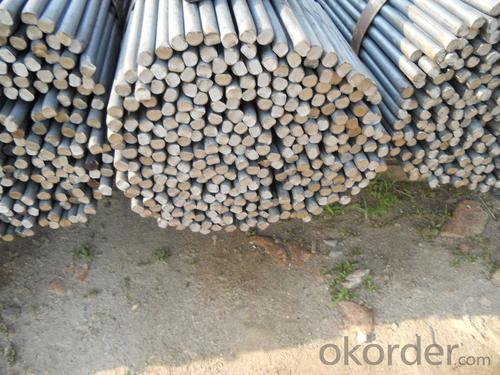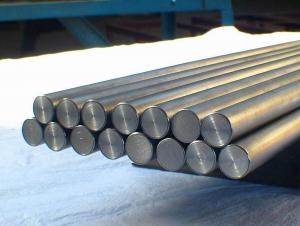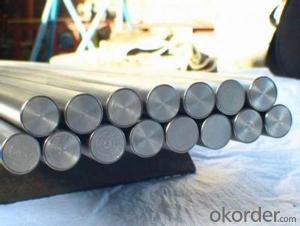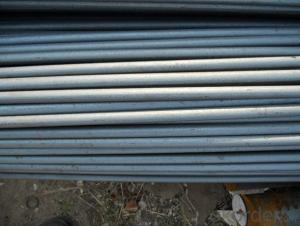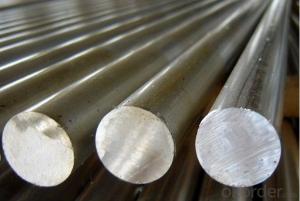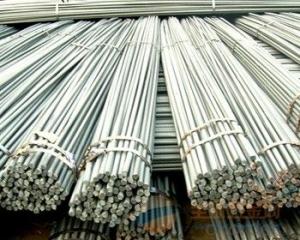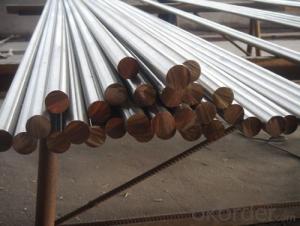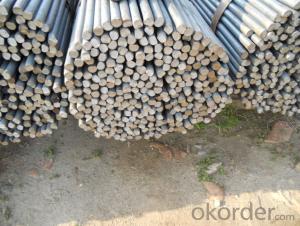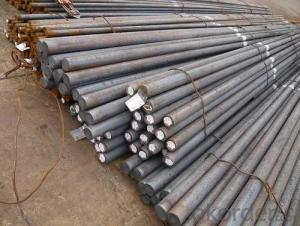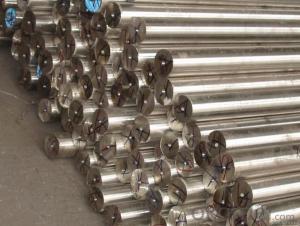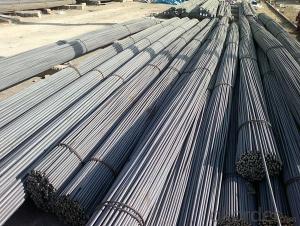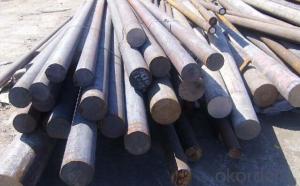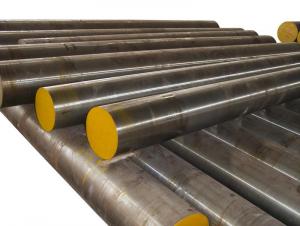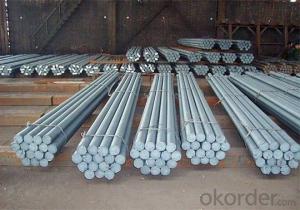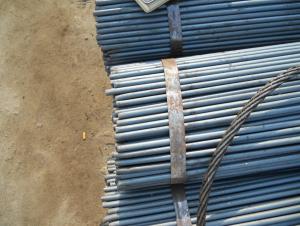Hot Rolled Steel Round Bar with High Quality for Construction
- Loading Port:
- China main port
- Payment Terms:
- TT or LC
- Min Order Qty:
- 25000 m.t.
- Supply Capability:
- 100000 m.t./month
OKorder Service Pledge
OKorder Financial Service
You Might Also Like
Specifications of Hot Rolled Steel Round Bar with High Quality for Construction:
1. Grade: Q235,Q345
2. Type: Mild carbon steel
3. Shape: Round bar, solid bar of steel with circular section
4. Diameter: 8mm-150mm
5. HS Code: 72283010
Usage and Applications of Hot Rolled Steel Round Bar with High Quality for Construction:
1. Common Steel Round Bar of 8-25mm, or small round is mostly used for straight bundles supply, and used for steel, bolts and various mechanical parts. While the bigger round bar, or more than 25mm hot rolled bar, is mainly for the manufacture of mechanical parts or for seamless steel billet.
2. Steel round bar is used in construction and a large number of architectural and engineering structures.
3. Besides, we can supply some especial material steel round bar that can be used for main shaft of steamer, hummer shank, with big section and supper force.
Packaging & Delivery of Hot Rolled Steel Round Bar with High Quality for Construction:
Packaging Detail: All goods are packed in bundle with steel strips and shipped by break bulk vessel or container (depend on target market and different ports)
Delivery Detail: 45 days
Trade terms: FOB, CFR, CIF
MOQ: 25 tons per specification; we can negotiate the quantity if the specification is normal or we have stock of one specification.
Weight: The price invoicing on theoretical weight basis or actual weight basis depends on customer’s request.
Shipment: The shipment of bulk break or container is depends on customer’s request and the situation of the port of destination.
Documents given: Full set of original clean on board bill of lading; Original signed commercial invoice; Original packing list; Policy of insurance; Certificate of origin and what the target market needs.
Production Flow of Hot Rolled Steel Round Bar with High Quality for Construction:
We use advanced equipments like Electric Arc Furnace, Ladle Furnace and Vacuum Degasser to produce our products.
Material prepare (billet) — heat up — rough rolling — precision rolling — cooling — packing — storage and transportation
FAQ:
Q1: Why buy Materials & Equipment from OKorder.com?
A1: All products offered byOKorder.com are carefully selected from China's most reliable manufacturing enterprises. Through its ISO certifications, OKorder.com adheres to the highest standards and a commitment to supply chain safety and customer satisfaction.
Q2: What makes stainless steel stainless?
A2: Stainless steel must contain at least 10.5 % chromium. It is this element that reacts with the oxygen in the air to form a complex chrome-oxide surface layer that is invisible but strong enough to prevent further oxygen from "staining" (rusting) the surface. Higher levels of chromium and the addition of other alloying elements such as nickel and molybdenum enhance this surface layer and improve the corrosion resistance of the stainless material.
Q3: Can stainless steel rust?
A3: Stainless does not "rust" as you think of regular steel rusting with a red oxide on the surface that flakes off. If you see red rust it is probably due to some iron particles that have contaminated the surface of the stainless steel and it is these iron particles that are rusting. Look at the source of the rusting and see if you can remove it from the surface.
Images:
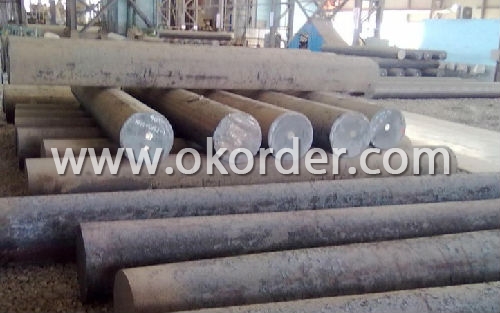
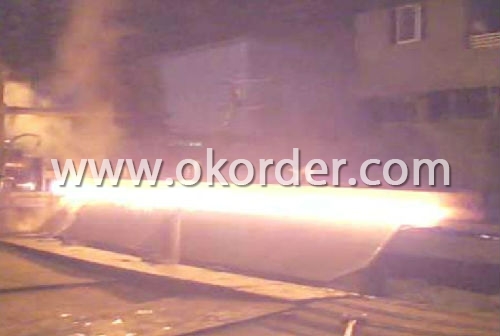
- Q: Can steel round bars be used for making gears or sprockets?
- Yes, steel round bars can be used for making gears or sprockets. Steel is a commonly used material for gears and sprockets due to its strength, durability, and ability to withstand high loads and friction. The round bars can be machined or shaped into the desired gear or sprocket design, providing a reliable and efficient solution for various applications.
- Q: Can steel round bars be used for structural purposes?
- Yes, steel round bars can be used for structural purposes. They are commonly used in the construction industry for various applications, such as providing support and reinforcement in buildings, bridges, and other structures. The high strength and durability of steel make round bars an ideal choice for structural use, as they can withstand heavy loads and provide stability.
- Q: What are the different types of steel round bars used in the defense industry?
- In the defense industry, various steel round bars are commonly employed due to their strength, durability, and ability to withstand harsh conditions. Some of the frequently utilized types are as follows: 1. High-strength low-alloy (HSLA) steel round bars: These bars possess a high strength-to-weight ratio, making them ideal for applications where weight reduction is crucial. They find extensive use in the construction of armored vehicles, tanks, and other military equipment. 2. Stainless steel round bars: Stainless steel exhibits remarkable resistance to corrosion and rust, making it an excellent choice for defense applications exposed to moisture or harsh environments. Its wide usage includes the manufacturing of military aircraft, naval vessels, and firearms. 3. Carbon steel round bars: Carbon steel is a versatile and cost-effective material extensively used in the defense industry. It offers excellent strength and hardness, making it suitable for various applications, such as missile components, gun barrels, and armor plates. 4. Alloy steel round bars: Alloy steel is a blend of different metals, typically including chromium, molybdenum, and nickel, which enhances its mechanical properties. It finds common application in the production of military-grade vehicles, artillery systems, and munitions. 5. Tool steel round bars: Tool steel is specifically designed to possess exceptional hardness, wear resistance, and toughness. It is often employed in the manufacturing of cutting tools, drills, and other equipment utilized in the defense industry. Each type of steel round bar possesses unique properties and advantages, enabling it to meet specific requirements within the defense sector. The selection of the appropriate steel round bar depends on the specific application and the desired performance characteristics needed to meet the demands of the defense industry.
- Q: Are steel round bars suitable for the production of axles?
- Yes, steel round bars are suitable for the production of axles. Steel round bars are known for their high strength and durability, making them ideal for the heavy-duty requirements of axles. They can withstand the forces and stresses applied during operation, ensuring the axles can efficiently support and transmit the load. The round shape of the bars also allows for easy machining and forming into axles of various sizes and configurations.
- Q: What are the different surface treatments for steel round bars?
- Steel round bars offer a variety of surface treatments, each serving a specific purpose and offering unique advantages. Here are some of the most common treatments: 1. Hot-dip galvanizing: To prevent corrosion and rusting, steel round bars are immersed in molten zinc, creating a protective coating. This treatment is ideal for outdoor or corrosive environments. 2. Painting: Applying paint not only enhances the appearance of steel round bars but also protects them from moisture and oxidation. It is commonly used for decorative purposes or when a specific color is desired. 3. Powder coating: Dry powder is applied to the steel round bars and then cured under heat, resulting in a durable and appealing finish. This treatment provides excellent resistance to impact, chemicals, and UV rays. 4. Electropolishing: A smooth and shiny finish is achieved by using an electric current and an electrolyte solution to remove a thin layer from the steel round bars' surface. It enhances the appearance and corrosion resistance, making it suitable for applications requiring cleanliness and aesthetics. 5. Passivation: An acid solution is used to remove any free iron or iron oxide from the surface of steel round bars, improving their corrosion resistance. This treatment is commonly used for stainless steel round bars to increase longevity and prevent staining or rusting. 6. Shot blasting: Small steel balls or particles are propelled at high velocity onto the steel round bars, removing contaminants, scale, or rust. This results in a clean and roughened surface, improving adhesion for subsequent coatings or treatments. 7. Chrome plating: A thin layer of chromium is electroplated onto the surface of steel round bars, providing corrosion resistance, wear resistance, and a shiny appearance. This treatment is suitable for applications requiring durability and aesthetics. The choice of surface treatment for steel round bars depends on specific requirements such as corrosion resistance, aesthetics, or wear resistance. Before selecting a treatment, it is important to carefully consider the intended use and environmental conditions.
- Q: Can steel round bars be used in the production of telecommunications equipment?
- Yes, steel round bars can be used in the production of telecommunications equipment. Steel round bars are commonly used in various industries, including telecommunications, due to their strength, durability, and versatility. They can be used to create structural components, frames, supports, and mounting brackets for telecommunications equipment. Steel round bars can also be machined and shaped into specific forms required for different equipment applications. Additionally, steel round bars can provide necessary electromagnetic shielding and grounding capabilities, which are essential for telecommunications equipment to function properly.
- Q: Are steel round bars suitable for use in the mining industry?
- Yes, steel round bars are suitable for use in the mining industry. Steel round bars are known for their strength and durability, making them ideal for use in the mining industry where heavy-duty equipment and machinery are utilized. These bars can be used for various applications such as shafts, support beams, and structural components in underground mines, open-pit mines, and processing plants. Steel round bars are capable of withstanding high loads and pressures, making them suitable for harsh mining environments. They have excellent tensile strength and can withstand extreme temperatures, making them resistant to wear, abrasion, and impact. This is crucial in mining operations where equipment is subjected to heavy loads, vibrations, and constant movement. Moreover, steel round bars can be easily welded, fabricated, and machined according to specific requirements, making them versatile and adaptable to a wide range of mining applications. They can be customized to different sizes, lengths, and shapes, ensuring a perfect fit for various mining equipment and structures. In addition to their strength and versatility, steel round bars also offer cost-effectiveness and long-term value. They have a long lifespan, require minimal maintenance, and can withstand the harsh conditions typically found in mining operations, reducing the need for frequent replacements or repairs. Overall, steel round bars are a reliable and suitable choice for the mining industry due to their strength, durability, versatility, and cost-effectiveness. They provide the necessary support and structural integrity required for mining operations, ensuring the safety and efficiency of the industry.
- Q: Can steel round bars be used in the agriculture industry?
- Steel round bars find extensive use in the agriculture industry, where they serve a multitude of purposes. Commonly employed in the construction of farm equipment, fencing, and building structures, steel round bars are renowned for their robustness and longevity, rendering them ideal for demanding tasks within the agricultural sector. Moreover, these bars exhibit exceptional resistance to harsh weather conditions and corrosion, thereby ensuring their enduring reliability and durability in agricultural settings. In essence, steel round bars emerge as a versatile and pragmatic option for the agriculture industry, owing to their immense strength, durability, and ability to withstand environmental factors.
- Q: How do you prevent rusting of steel round bars?
- To prevent rusting of steel round bars, there are several effective measures that can be taken: 1. Apply a protective coating: One of the most common ways to prevent rusting is by applying a protective coating on the steel round bars. This can be done by using paint, varnish, or a specialized rust-preventive coating. The coating acts as a barrier between the steel surface and the surrounding environment, preventing moisture and oxygen from reaching the metal and causing rust. 2. Keep the steel dry: Moisture is a key factor that contributes to the corrosion of steel. Therefore, it is crucial to keep the steel round bars as dry as possible. This can be achieved by storing them in a dry environment or using dehumidifiers in areas where moisture levels are high. 3. Maintain proper ventilation: Adequate ventilation helps in preventing the accumulation of moisture around the steel round bars. Good air circulation allows any moisture that may be present to evaporate, reducing the risk of rust formation. 4. Implement a rust inhibitor: Rust inhibitors, also known as corrosion inhibitors, can be applied to the steel round bars to prevent rust formation. These inhibitors work by chemically reacting with the metal surface, forming a protective layer that inhibits the oxidation process. Rust inhibitors can be in the form of oils, waxes, or specialized compounds. 5. Store in a controlled environment: If the steel round bars are not immediately being used, it is essential to store them in a controlled environment. This typically means keeping them in a dry, temperature-controlled area to minimize exposure to moisture and extreme temperatures, both of which can accelerate rust formation. 6. Regular maintenance and inspection: It is advisable to regularly inspect the steel round bars for signs of rust or damage. If any rust spots are detected, they should be promptly cleaned and treated with a rust remover or inhibitor to prevent further corrosion. By following these preventive measures, the rusting of steel round bars can be significantly reduced, ensuring their longevity and maintaining their structural integrity.
- Q: What is the difference between a hot rolled and a precision ground steel round bar?
- The main difference between a hot rolled and a precision ground steel round bar is the manufacturing process and the resulting surface finish. Hot rolled steel round bars are made by heating a steel billet until it is soft enough to be formed into a round shape, then rolling it through a series of rollers to achieve the desired diameter. This process creates a rougher surface finish and can result in slight variations in diameter along the length of the bar. On the other hand, precision ground steel round bars are made by starting with a hot rolled bar and then subjecting it to additional grinding or machining processes to achieve a precise diameter and a smooth, consistent surface finish. This extra processing ensures that the bar has a more uniform size and a finer surface texture, making it suitable for applications that require tight tolerances and a polished appearance. Overall, the choice between a hot rolled and a precision ground steel round bar depends on the specific requirements of the application. Hot rolled bars are generally more cost-effective and suitable for less demanding applications, while precision ground bars are preferred for precision machining and high-performance applications.
Send your message to us
Hot Rolled Steel Round Bar with High Quality for Construction
- Loading Port:
- China main port
- Payment Terms:
- TT or LC
- Min Order Qty:
- 25000 m.t.
- Supply Capability:
- 100000 m.t./month
OKorder Service Pledge
OKorder Financial Service
Similar products
Hot products
Hot Searches
Related keywords




